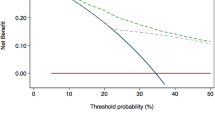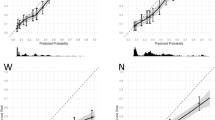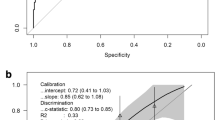Abstract
Purpose
Accurate prediction of extraprostatic extension (EPE) is crucial for decision-making in radical prostatectomy (RP), especially in nerve-sparing strategies. Martini et al. introduced a three-tier algorithm for predicting contralateral EPE in unilateral high-risk prostate cancer (PCa). The aim of the study is to externally validate this model in a multicentric European cohort of patients.
Methods
The data from 208 unilateral high-risk PCa patients diagnosed through magnetic resonance imaging (MRI)-targeted and systematic biopsies, treated with RP between January 2016 and November 2021 at eight referral centers were collected. The evaluation of model performance involved measures such as discrimination (AUC), calibration, and decision-curve analysis (DCA) following TRIPOD guidelines. In addition, a comparison was made with two established multivariable logistic regression models predicting the risk of side specific EPE for assessment purposes.
Results
Overall, 38%, 48%, and 14% of patients were categorized as low, intermediate, and high-risk groups according to Martini et al.’s model, respectively. At final pathology, EPE on the contralateral prostatic lobe occurred in 6.3%, 12%, and 34% of patients in the respective risk groups. The algorithm demonstrated acceptable discrimination (AUC 0.68), comparable to other multivariable logistic regression models (p = 0.3), adequate calibration and the highest net benefit in DCA. The limitations include the modest sample size, retrospective design, and lack of central revision.
Conclusion
Our findings endorse the algorithm's commendable performance, supporting its utility in guiding treatment decisions for unilateral high-risk PCa patients.


Similar content being viewed by others
Data availability
Data are available from the corresponding author upon reasonable request.
References
Vis AN, van den Bergh RCN, van der Poel HG, Mottrie A, Stricker PD, Graefen M et al (2022) Selection of patients for nerve sparing surgery in robot-assisted radical prostatectomy. BJUI Compass 3:6–18. https://doi.org/10.1002/bco2.115
Diamand R, Ploussard G, Roumiguié M, Oderda M, Benamran D, Fiard G et al (2021) External validation of a multiparametric magnetic resonance imaging-based nomogram for the prediction of extracapsular extension and seminal vesicle invasion in prostate cancer patients undergoing radical prostatectomy. Eur Urol 79:180–185. https://doi.org/10.1016/j.eururo.2020.09.037
Kwong JCC, Khondker A, Meng E, Taylor N, Kuk C, Perlis N et al (2023) Development, multi-institutional external validation, and algorithmic audit of an artificial intelligence-based side-specific extra-prostatic extension risk assessment tool (SEPERA) for patients undergoing radical prostatectomy: a retrospective cohort study. Lancet Digit Heal 5:e435–e445. https://doi.org/10.1016/S2589-7500(23)00067-5
Diamand R, Roche J-B, Lievore E, Lacetera V, Chiacchio G, Beatrici V et al (2022) External validation of models for prediction of side-specific extracapsular extension in prostate cancer patients undergoing radical prostatectomy. Eur Urol Focus. https://doi.org/10.1016/j.euf.2022.09.006
Martini A, Soeterik TFW, Haverdings H, Rahota RG, Checcucci E, De Cillis S et al (2022) An algorithm to personalize nerve sparing in men with unilateral high-risk prostate cancer. J Urol 207:350–357. https://doi.org/10.1097/JU.0000000000002205
Turkbey B, Rosenkrantz AB, Haider MA, Padhani AR, Villeirs G, Macura KJ et al (2019) Prostate imaging reporting and data system version 2.1: 2019 update of prostate imaging reporting and data system version 2. Eur Urol 76:340–351. https://doi.org/10.1016/j.eururo.2019.02.033
Epstein JI, Egevad L, Amin MB, Delahunt B, Srigley JR, Humphrey PA (2015) The 2014 international society of urological pathology (ISUP) consensus conference on Gleason grading of prostatic carcinoma. Am J Surg Pathol 40:1. https://doi.org/10.1097/PAS.0000000000000530
Collins GS, Reitsma JB, Altman DG, Moons KGM (2015) Transparent reporting of a multivariable prediction model for individual prognosis or diagnosis (TRIPOD): the TRIPOD statement. Eur Urol 67:1142–1151. https://doi.org/10.1016/j.eururo.2014.11.025
Soeterik TFW, van Melick HHE, Dijksman LM, Küsters-Vandevelde H, Stomps S, Schoots IG et al (2020) Development and external validation of a novel nomogram to predict side-specific extraprostatic extension in patients with prostate cancer undergoing radical prostatectomy. Eur Urol Oncol. https://doi.org/10.1016/j.euo.2020.08.008
Martini A, Gupta A, Lewis SC, Cumarasamy S, Haines KG, Briganti A et al (2018) Development and internal validation of a side-specific, multiparametric magnetic resonance imaging-based nomogram for the prediction of extracapsular extension of prostate cancer. BJU Int 122:1025–1033. https://doi.org/10.1111/bju.14353
DeLong ER, DeLong DM, Clarke-Pearson DL (1988) Comparing the areas under two or more correlated receiver operating characteristic curves: a nonparametric approach. Biometrics 44:837–845
Vickers AJ, Elkin EB (2006) Decision curve analysis: a novel method for evaluating prediction models. Med Decis Mak. https://doi.org/10.1177/0272989X06295361
Mithal P, Howard LE, Aronson WJ, Terris MK, Cooperberg MR, Kane CJ et al (2016) Positive surgical margins in radical prostatectomy patients do not predict long-term oncological outcomes: results from the shared equal access regional cancer hospital (SEARCH) cohort. BJU Int 117:244–248. https://doi.org/10.1111/bju.13181
Würnschimmel C, Wenzel M, Wang N, Tian Z, Karakiewicz PI, Graefen M et al (2021) Radical prostatectomy for localized prostate cancer: 20-year oncological outcomes from a German high-volume center. Urol Oncol Semin Orig Investig 39:830.e17-830.e26. https://doi.org/10.1016/j.urolonc.2021.04.031
van der Slot MA, den Bakker MA, Tan TSC, Remmers S, Busstra MB, Gan M et al (2022) NeuroSAFE in radical prostatectomy increases the rate of nerve-sparing surgery without affecting oncological outcome. BJU Int 130:628–636. https://doi.org/10.1111/bju.15771
Baas DJH, Vreuls W, Sedelaar JPM, Vrijhof HJEJ, Hoekstra RJ, Zomer SF et al (2023) Confocal laser microscopy for assessment of surgical margins during radical prostatectomy. BJU Int 132:40–46. https://doi.org/10.1111/bju.15938
Dinneen E, Grierson J, Almeida-Magana R, Clow R, Haider A, Allen C et al (2022) NeuroSAFE PROOF: study protocol for a single-blinded, IDEAL stage 3, multi-centre, randomised controlled trial of NeuroSAFE robotic-assisted radical prostatectomy versus standard robotic-assisted radical prostatectomy in men with localized prostate cancer. Trials 23:584. https://doi.org/10.1186/s13063-022-06421-7
van der Slot MA, den Bakker MA, Klaver S, Kliffen M, Busstra MB, Rietbergen JBW et al (2020) Intraoperative assessment and reporting of radical prostatectomy specimens to guide nerve-sparing surgery in prostate cancer patients (NeuroSAFE). Histopathology 77:539–547. https://doi.org/10.1111/his.14184
Dinneen E, Haider A, Grierson J, Freeman A, Oxley J, Briggs T et al (2021) NeuroSAFE frozen section during robot-assisted radical prostatectomy: peri-operative and histopathological outcomes from the NeuroSAFE PROOF feasibility randomized controlled trial. BJU Int 127:676–686. https://doi.org/10.1111/bju.15256
Beyer B, Schlomm T, Tennstedt P, Boehm K, Adam M, Schiffmann J et al (2014) A feasible and time-efficient adaptation of NeuroSAFE for da Vinci robot-assisted radical prostatectomy. Eur Urol 66:138–144. https://doi.org/10.1016/j.eururo.2013.12.014
Rocco B, Cimadamore A, Sarchi L, Bonetti LR, Bertoni L, Azzoni P et al (2021) Current and future perspectives of digital microscopy with fluorescence confocal microscope for prostate tissue interpretation: a narrative review. Transl Androl Urol 10:1569–1580. https://doi.org/10.21037/tau-20-1237
Hofman MS, Lawrentschuk N, Francis RJ, Tang C, Vela I, Thomas P et al (2020) Prostate-specific membrane antigen PET-CT in patients with high-risk prostate cancer before curative-intent surgery or radiotherapy (proPSMA): a prospective, randomised, multicentre study. Lancet 395:1208–1216. https://doi.org/10.1016/S0140-6736(20)30314-7
Sonni I, Felker ER, Lenis AT, Sisk AE, Bahri S, Allen-Auerbach M et al (2022) Head-to-head comparison of 68 Ga-PSMA-11 PET/CT and mpMRI with a histopathology gold standard in the detection, intraprostatic localization, and determination of local extension of primary prostate cancer: results from a prospective single-center imaging. J Nucl Med 63:847–854. https://doi.org/10.2967/jnumed.121.262398
Lehner F, Crippa A, Sigg S, Eberli D, Mortezavi A (2023) Transperineal template saturation and conventional biopsy for stage prediction in prostate cancer. BJU Int 132:696–704. https://doi.org/10.1111/bju.16181
Funding
None.
Author information
Authors and Affiliations
Contributions
Diamand R.: Project development, Data collection, Data analysis, Manuscript writing. Albisinni S., Peltier A., Roumeguere T.: Manuscript editing. Roche JB, Lacetera V., Simone G., Windisch O., Benamran D., Fourcade A., Fournier G., Fiard G., Ploussard G.: Data collection. Albisinni S.: Project development, Supervision.
Corresponding author
Ethics declarations
Conflict of interest
None.
Ethical approval and informed consent
This is a retrospective study. All the procedures were performed as part of the routine care. Then, our study did not need ethical approval and no formal consent was required. The procedures used in this study adhere to the principles of the Declaration of Helsinki.
Additional information
Publisher's Note
Springer Nature remains neutral with regard to jurisdictional claims in published maps and institutional affiliations.
Supplementary Information
Below is the link to the electronic supplementary material.
Rights and permissions
Springer Nature or its licensor (e.g. a society or other partner) holds exclusive rights to this article under a publishing agreement with the author(s) or other rightsholder(s); author self-archiving of the accepted manuscript version of this article is solely governed by the terms of such publishing agreement and applicable law.
About this article
Cite this article
Diamand, R., Roche, JB., Lacetera, V. et al. Predicting contralateral extraprostatic extension in unilateral high-risk prostate cancer: a multicentric external validation study. World J Urol 42, 247 (2024). https://doi.org/10.1007/s00345-024-04966-7
Received:
Accepted:
Published:
DOI: https://doi.org/10.1007/s00345-024-04966-7




